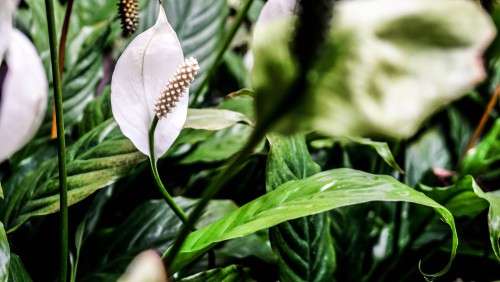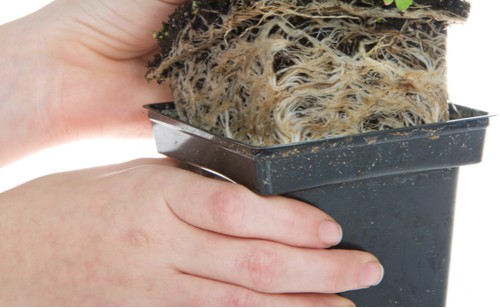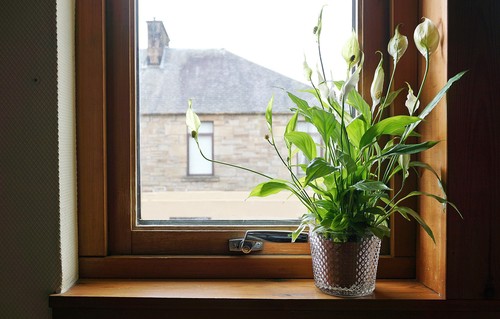Last updated on March 24th, 2022
Our site is reader supported, this means we may earn a small commission from Amazon and other affiliates when you buy through links on our site.
A Peace Lily is happiest when the roots are ever so slightly crowded, but when it’s time to give your plant some more space, it will let you know. How can you recognise when it’s time to repot your Peace Lily?
The first sign you will notice that it needs repotting is that it will start to wilt more frequently between watering because the soil is unable to retain much moisture when watered, and it usually just runs straight through the pot and out of the drainage holes.

When should I be repotting a Peace Lily?
If your Peace Lily is rootbound, it’s time to re-pot, the roots like to be partly restricted but they don’t like being rootbound to a point where the roots are coming to the surface of the soil or coming out of the bottom of the pot.
You can tell if your plant is rootbound by lifting up the container carefully and looking underneath. If through the drainage holes, you see all of the roots mergings, or perhaps the roots are sticking up through the surface of your soil, it’s time to get a bigger pot for your plant.
Most people see rootbound plants at garden centres when they pick up a small container and it looks like white tentacles are sticking out, every which way, or forming some sort of mass underneath the container itself. This is, effectively, what you are looking for with your Peace Lily, although hopefully not in so advanced at this stage.

Rootbound plants are unable to absorb water properly because their roots are packed together so tightly. Even if you don’t notice the roots themselves, when you water them generously you might see that the water just goes straight through the drainage holes into the bottom of the container and the plant is still wilting.
If you notice these signs, it is in your best interest to re-pot as soon as possible, but if the signs are just beginning to manifest and your plant can hold on a little bit longer, wait until spring to re-pot your Peace Lily.
How to re-pot a Peace Lily
Choose a pot only slightly larger than its current container
For your houseplant, you want to select a new pot that is slightly larger, maybe between 3-6cm wider than the current container. You don’t want to plant it in a substantially larger container because the excess potting compost will lead to increased moisture retention which can result in root rot. The same as any other container, make sure that the drainage holes are ample and then cover them with grit or small stone to prevent the potting mix from washing straight through.

Water your plant before potting it into a new pot
As you prepare to re-pot your Peace Lily, water it in its existing container about an hour or two ahead of time. In the interim, put the fresh houseplant potting compost into your new container. You want to use just enough potting compost that once your Peace Lily is repotted, the top of the root ball will remain about 3cm below the rim. Effectively your goal here is to make sure that the plant is sitting at the same level as it was an old pot and certainly not planted any deeper. If you bury it too deeply this can lead to root rot.
Carefully remove the Peace Lily from its pot and gently tease the roots out if they are rootbound
Once the one or two-hour time frame is up, slide the Peace Lily carefully out of its current container and gently tease the root ball with your fingers releasing any roots that are compacted.
Place it in the new container and fill in the root ball with the extra potting compost, gently pressing down the mixture with your fingers but not too compact because this will restrict root growth. Water it ever-so-slightly so that the soil has a chance to settle and then, if necessary, add a little more potting soil on top to make sure that the plant is at the same level as it was in the old container.
Don’t feed a newly potted Peace Lily for at least 3 months
Put it somewhere shady for the next few days. It might look a little worse for the wear with some slight wilting but it will bounce back. Don’t feed for a few months after repotting so that your plant has an opportunity to establish itself in its new pot.
Dividing large plants at the same time as repotting is worth considering
If you have a very mature plant you might use this as an opportunity to divide it into smaller plants, carefully removing offshoots and putting each one in a small pot with new potting soil.
That being said, you now know how to keep your eyes peeled for the telltale signs of repotting time, and you know how to do it properly. With that, you can keep your Peace Lily properly tended to and maintained for years to come.


